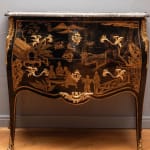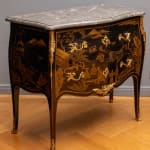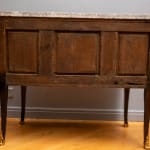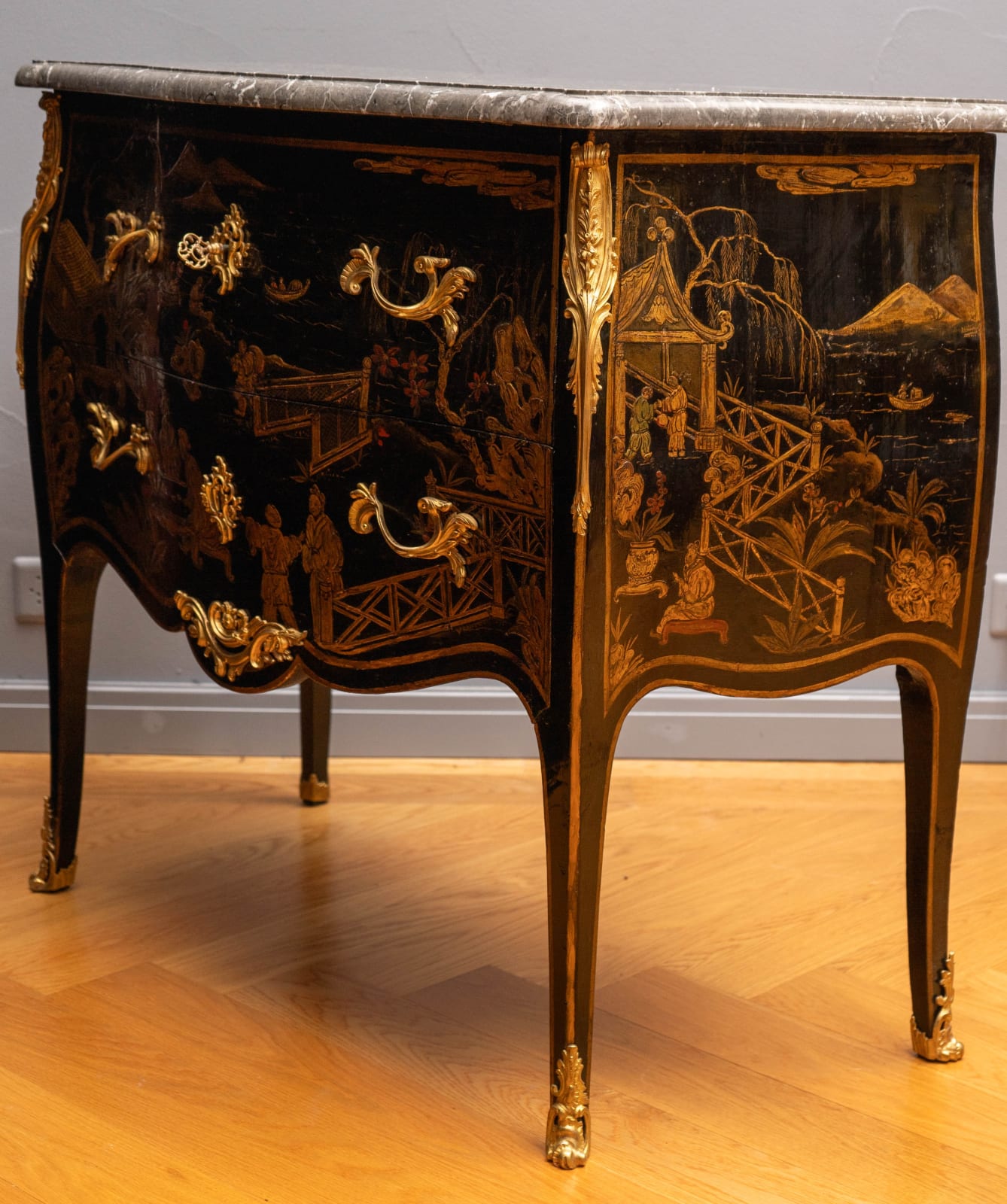Unknown
Further images
-
(View a larger image of thumbnail 1
)

-
(View a larger image of thumbnail 2
)

-
(View a larger image of thumbnail 3
)

-
(View a larger image of thumbnail 4
)

-
(View a larger image of thumbnail 5
)

-
(View a larger image of thumbnail 6
)

-
(View a larger image of thumbnail 7
)

-
(View a larger image of thumbnail 8
)

A very fine Louis XV gilt bronze mounted Oriental lacquer commode, surmounted by a shaped rectangular serpentine-fronted grey marble top above a bombé front with two drawers, the front decorated overall with an Oriental scene painted in gold and red on a black lacquered ground portraying mountains, cherry blossom trees, foliage, rocks, pagodas, bridges and figures walking, fishing and with three ladies seated at a low table, the whole within a shaped gilt border, each drawer with a pair of gilt bronze serpentine foliate pulls flanking a rocaille shaped escutcheon, with a further rocaille mount centring the shaped apron below and also with foliate rocaille angle mounts. Each of the sides with conformingly coloured Oriental lacquered scenes within a shaped gilt border, portraying on the left-hand side mountains, a figure in a boat on a lake, a pagoda and people fishing while in the foreground steps lead up to a pavilion; the right-hand side portraying clouds above mountains and figures in a boat on a lake, and to its left a tree behind a pagoda with figures either in conversation or seated on a balustraded balcony. The whole on cabriole legs terminated by foliate sabots
Paris, date circa 1740-50
Height 93.5 cm, length 106 cm, depth 50 cm.
During the mid eighteenth century, it became highly fashionable in France to adorn commodes, consoles, bureaux and other pieces of furniture with Japanese and Chinese lacquered panels. The taste for the Orient was itself a significant aspect of the Rococo style, that initially dominated the decorative arts and subsequently painting, sculpture and architecture during the reign of Louis XV. The Rococo style was predominantly a reaction against the solemnity of the preceding Baroque and was characterised by light and freely handled C and S-shaped curves, bright clear colours, a harmonious combination of natural motifs such as sprigs of flowers and rockwork with nonrepresentational ornament and a tendency toward asymmetry, hence this commode has a bombé front, its angles and top are sinuous and the mounts, which are asymmetrical, are inspired by rocaille or rockwork ornament. Chinoiserie and other exotic motifs were extensively used within Rococo design, and it is because of this that Oriental lacquer panels were often used as veneers for some of the more sumptuous pieces of furniture. This innovation was largely due to the marchands-mercier owing to their historical role as traders in exotic materials. The Parisian marchands-mercier, especially Thomas-Joachim Hébert, Simon-Philippe Poirier and Darnault made a speciality of Oriental lacquer and were among the few dealers who could afford such wares. They were able to obtain lacquer panels direct from the Far East through the Dutch East India Company, who in the eighteenth century had a monopoly of trade with Japan.
The best quality Oriental lacquer was made from the sap of the rhus vernicifera tree (indigenous to China but then later introduced to Japan), which dries very hard and takes on a high polish. The preparation of lacquer was a lengthy process. The method for extracting the sap involved making an incision in the tree trunk; the sap was then collected in a cup. The greyish sap, which turned black on contact with the air, then had to be purified and strained before use. Once the superfluous moisture was removed by heating, it was given various colours and textures. In the best Oriental lacquers as many as thirty or more coats were given, each being allowed to dry and be polished before the next layer was applied.
The present ornate commode compares closely with a number of others made during the mid eighteenth century by an elite group of leading ébénistes that supplied the luxury market, usually via the Paris marchands-mercier. Among these master craftsmen, one can cite Mathieu Criaerd (1689-1776), Jacques Dubois (1694-1763), Bernard II Vanrisamburghknown as B.V.R.B. (circa 1696-1766) and Pierre Roussel (1723-82). Amongst examples by Roussel, who was received as maître in 1745, is a comparable bombé commode of circa 1760 featuring similar Chinese lacquer scenes that is fitted with similar but slightly more profuse gilt bronze mounts, illustrated in Alexandre Pradère, “French Furniture Makers”, 1989, p. 206, pl. 201. Pradère’s book (p. 170, pl. 147) also features a very closely related black and gold Chinese lacquer commode by Jacques Dubois with comparable gilt bronze mounts. Dubois who was born in Pontoise and worked for many years as an ouvrier privilégié in Paris in the Faubourg Saint-Antoine, only became a maître in 1742 at the relatively late age of forty-eight. Unlike many of his contemporaries, Dubois was not dependent upon the patronage of the powerful and influential marchands-mercier, although he did occasionally supply pieces to Léger Bertin, François Machart and Deyle-François Labrunne, as well as the marchand-ébéniste Pierre Migeon. Other comparable examples by Dubois feature in Pierre Kjellberg’s book “Le Mobilier Français du XVIIIe Siècle”, 1998, pp. 268-69, pls. A-G, showing seven Oriental lacquer pieces of furniture by Dubois including two comparable commodes (pls. A and B) as well as a bureau plat housed in the Musée du Louvre (pl. E), which is decorated with Japanese lacquer panels.
As noted Mathieu Criaerd was among a group of mid eighteenth century ébénistes that created superb Oriental lacquer commodes for the luxury market including one of very similar overall design with comparable gilt bronze mounts that is decorated with Chinese lacquer featuring exotic birds, flora and fauna (illustrated in Pradère, op. cit, p. 222, pl. 221) as well as three further lacquer commodes of similar design (illustrated in Kjellberg, op. cit, pp. 215, 216, pl. A, and 217, pl. C). Like Dubois, Criaerd was relatively mature when at the age of forty-nine, in 1738, he was received as a maître ébéniste. During the 1740s he worked for the marchand-mercier Thomas-Joachim Hébert, through whom he supplied furniture to Louis XV’s mistress, Mlle de Mailly at Choisy and furnishings for the cabinet of the Dauphin at Versailles.
B.V.R.B., who is now regarded as the greatest ébéniste working during Louis XV’s reign and was made a maître sometime before 1730, worked almost exclusively for the Paris merchants-mercier notably Hébert, Poirier and Lazare Duvaux, through whom his furniture was supplied to Louis XV, Mme de Pompadour, the Prince de Condé, the German courts and aristocracy. Among his productions, he made a number of Oriental lacquer pieces of furniture. Among them is a commode in the Musée du Louvre, Paris, which as the earliest recorded piece of furniture in Japanese lacquer, was supplied in 1737 by Thomas-Joachim Hébert for the Queen at Fontainebleau (illustrated in Pradère, op. cit, p. 195, pl. 187). Two other comparable commodes by B.V.R.B. were supplied by Hébert to the royal family, respectively in 1745 and 1750, of which a similar example, veneered in Japanese lacquer, from circa 1750, is illustrated in Pradère, op. cit, p. 194, pl. 184. In addition, a further comparison lacquer commode by the same master is housed in the Musée de Dijon, of which a similar example, formerly from Galerie Levy, is illustrated in Pradère, op. cit, p. 195, pl. 185.







